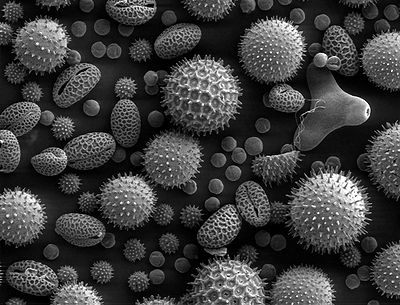
Sporopollenin
Encyclopedia

Spore
In biology, a spore is a reproductive structure that is adapted for dispersal and surviving for extended periods of time in unfavorable conditions. Spores form part of the life cycles of many bacteria, plants, algae, fungi and some protozoa. According to scientist Dr...
s and pollen
Pollen
Pollen is a fine to coarse powder containing the microgametophytes of seed plants, which produce the male gametes . Pollen grains have a hard coat that protects the sperm cells during the process of their movement from the stamens to the pistil of flowering plants or from the male cone to the...
grains. It is chemically very stable and is usually well preserved in soil
Soil
Soil is a natural body consisting of layers of mineral constituents of variable thicknesses, which differ from the parent materials in their morphological, physical, chemical, and mineralogical characteristics...
s and sediment
Sediment
Sediment is naturally occurring material that is broken down by processes of weathering and erosion, and is subsequently transported by the action of fluids such as wind, water, or ice, and/or by the force of gravity acting on the particle itself....
s. The exine layer is often intricately sculptured in species-specific patterns (see image at right), allowing material recovered from (for example) lake sediments to provide useful information to palynologists
Palynology
Palynology is the science that studies contemporary and fossil palynomorphs, including pollen, spores, orbicules, dinoflagellate cysts, acritarchs, chitinozoans and scolecodonts, together with particulate organic matter and kerogen found in sedimentary rocks and sediments...
about plant and fungal populations in the past. Sporopollenin has found uses in the field of paleoclimatology
Paleoclimatology
Paleoclimatology is the study of changes in climate taken on the scale of the entire history of Earth. It uses a variety of proxy methods from the Earth and life sciences to obtain data previously preserved within rocks, sediments, ice sheets, tree rings, corals, shells and microfossils; it then...
as well. Sporopollenin is also found in the cell walls of several taxa of green alga, including Phycopeltis
Phycopeltis
In taxonomy, Phycopeltis is a genus of algae, specifically of the Trentepohliaceae.-Scientific databases:* * *...
(an ulvophycean) and Chlorella
Chlorella
Chlorella is a genus of single-celled green algae, belonging to the phylum Chlorophyta. It is spherical in shape, about 2 to 10 μm in diameter, and is without flagella. Chlorella contains the green photosynthetic pigments chlorophyll-a and -b in its chloroplast...
.
The chemical composition of sporopollenin is not exactly known, due to its unusual chemical stability and resistance to degradation by enzyme
Enzyme
Enzymes are proteins that catalyze chemical reactions. In enzymatic reactions, the molecules at the beginning of the process, called substrates, are converted into different molecules, called products. Almost all chemical reactions in a biological cell need enzymes in order to occur at rates...
s and strong chemical reagents. Analyses have revealed a mixture of biopolymer
Biopolymer
Biopolymers are polymers produced by living organisms. Since they are polymers, Biopolymers contain monomeric units that are covalently bonded to form larger structures. There are three main classes of biopolymers based on the differing monomeric units used and the structure of the biopolymer formed...
s, containing mainly long chain fatty acid
Fatty acid
In chemistry, especially biochemistry, a fatty acid is a carboxylic acid with a long unbranched aliphatic tail , which is either saturated or unsaturated. Most naturally occurring fatty acids have a chain of an even number of carbon atoms, from 4 to 28. Fatty acids are usually derived from...
s, phenylpropanoid
Phenylpropanoid
The phenylpropanoids are a diverse family of organic compounds that are synthesized by plants from the amino acid phenylalanine. Their name is derived from the six-carbon, aromatic phenyl group and the three-carbon propene tail of cinnamic acid, which is synthesized from phenylalanine in the first...
s, phenol
Natural phenol
Natural phenols, bioavailable phenols, plant phenolics, low molecular weight phenols or phenoloids are a class of natural products. They are small molecules containing one or more phenolic group. These molecules are smaller in size than polyphenols, containing less than 12 phenolic groups...
ics and traces of carotenoid
Carotenoid
Carotenoids are tetraterpenoid organic pigments that are naturally occurring in the chloroplasts and chromoplasts of plants and some other photosynthetic organisms like algae, some bacteria, and some types of fungus. Carotenoids can be synthesized fats and other basic organic metabolic building...
s. Tracer experiments have shown that phenylalanine
Phenylalanine
Phenylalanine is an α-amino acid with the formula C6H5CH2CHCOOH. This essential amino acid is classified as nonpolar because of the hydrophobic nature of the benzyl side chain. L-Phenylalanine is an electrically neutral amino acid, one of the twenty common amino acids used to biochemically form...
is a major precursor, but other carbon sources also contribute. It is likely that sporopollenin derives from several precursors that are chemically cross-linked to form a rigid structure.
Electron microscopy shows that the tapetal cells that surround the developing pollen grain in the anther have a highly active secretory
Secretion
Secretion is the process of elaborating, releasing, and oozing chemicals, or a secreted chemical substance from a cell or gland. In contrast to excretion, the substance may have a certain function, rather than being a waste product...
system containing lipophilic globules. These globules are believed to contain sporopollenin precursors. Chemical inhibitors of pollen development and many male sterile mutants have effects on the secretion of these globules by the tapetal cells.
Sporopollenin has been applied in the nutrition and pharmaceutical fields by Kenrico
Kenrico
Kenrico is a pharmaceutical company headquartered in Shimada, Shizuoka, Japan. Established in 1985, the company focuses on pharmaceuticals related to nutrition, alternative medicine, toxin extraction, and organic green teas...
of Japan. They claim that it has medicinal and health benefits which can be applied via their Sap Sheet product, among other products.

